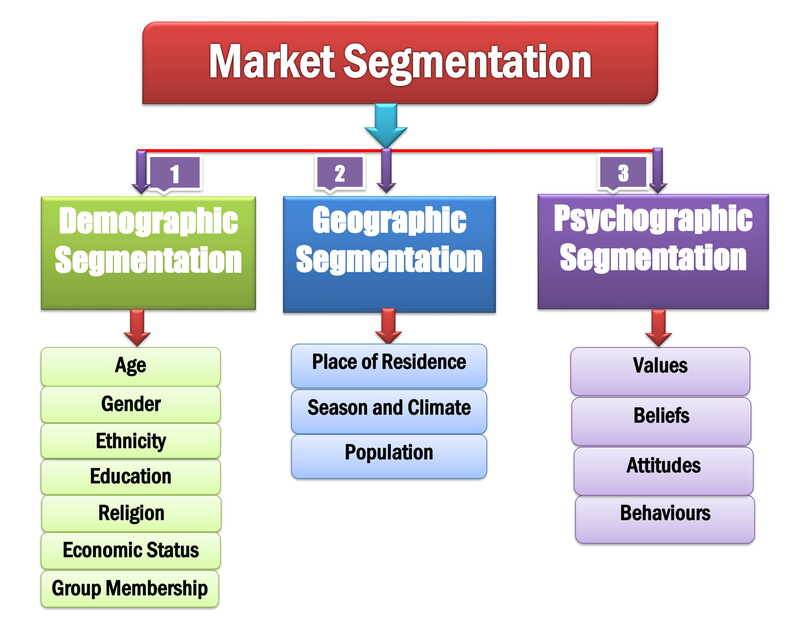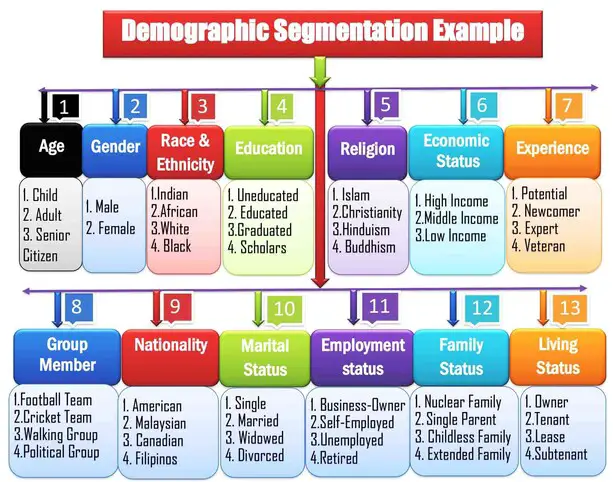TV Program Proposal Sample, How To Write a TV Program Proposal. TV Program Proposal: How To Write a Proposal For Television Program. The Full instruction for Writing a TV Proposal For Al-Hijrah Malaysian Television.
TV Program Proposal
The TV program proposal means a written complete description of a TV show that describes the entire program procedure. The proposal must include the program name, estimated budget, description, execution procedure, target audience segmentation, uniqueness, and program justification. A TV program proposal outlines the Television show thoroughly so that media authority identifies the output and future of the program. The TV program proposal is like a business proposal that describes the show before broadcasting on the channel.
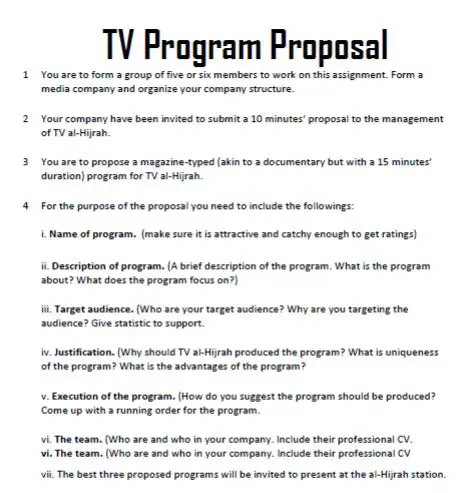
Elements of a TV Program Proposal
The 9 Elements of a TV Program Proposal are:
- Name of Program
- Description of Program
- Target audience
- The budget of the program
- Justification
- Execution of the Program
- The team
- The uniqueness of the program
- The strengths of the program
Instruction of Writing TV Program Proposal
| Instruction to write a proposal for the Al-Hijrah TV program |
| 1. You are to form a group of five or six members to work on this assignment. Form a media company and organize your company structure. |
| 2. Your company has been invited to submit a 10 minutes proposal to the management of TV Al-Hijrah. |
| 3. You propose a magazine-typed (akin to a documentary but with a 15 minutes duration) program for TV al-Hijrah. |
| 4. For the proposal, you need to include the followings:
i. Name of program. (make sure it is attractive and catchy enough to get ratings). ii. Description of the program. (A brief description of the program. What is the program about? What does the program focus on?) iii. Target audience. (Who is your target audience? Why are you targeting the audience? Give statistics to support this. iv. Justification. (Why should TV al-Hijrah produce the program? What is the uniqueness of the program? What are the advantages of the program? v. Execution of the program. (How do you suggest the program should be produced? Come up with a running order for the program. vi. The team. (Who are and who in your company. Include their professional CV. vii. The best three proposed programs will be invited to present at the Al-Hijrah station. |
The Sample of TV Program Proposal
Name of Program: Discover Student Talent (DST)-2023
Description of TV Program Proposal
Discover student talent is an attractive, inclusive TV program targeted toward students studying in the top-ranked public and private universities in Malaysia. This TV program will welcome students to explore their talents and help them to become famous by adequately utilizing their cognitive knowledge. The door to participation in this program is open for all students studying in Malaysian top 10 ranked universities. These top 10 universities will be considered as per the ranking of QS (Quacquarelli Symonds). According to the QS ranking, the top 10 universities in Malaysia are:
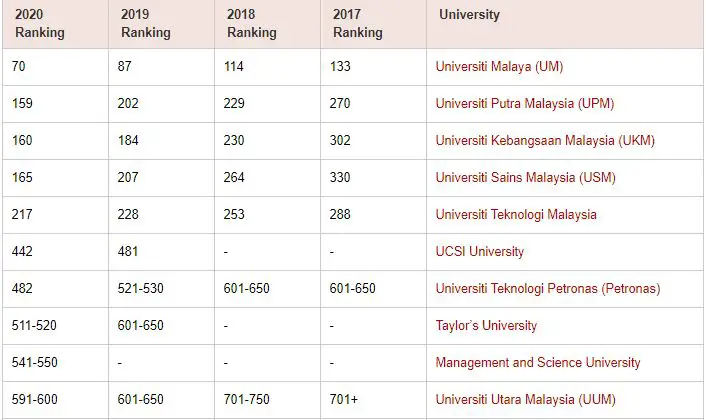
So, the student of these top 10 universities can participate in the Discover student talent program by enrolling via a specific mobile application or website. When they apply for contesting the Discover student talent program, contestants will have to participate in levels 1 and level 2 to secure a position among the top 20 students. The top 20 students from every university will go to the TV station in level 3 for contesting and securing positions in the top 10. In level 4, the top ten contestants will compete for being the most talented student in the university. The top 10 contestants from the top ten universities in Malaysia compete to be the most talented student in Malaysia. It is considered that the winner will get a certificate and 10,000 ringgit as prize money, following 5,000 ringgit for the runner-up and 2000 ringgit for the second runner-up.
Execution of the TV Program Proposal
Every student needs to create an account by providing a specific university name and student id number. When their account is activated, they can participate in question-answering sessions two times a month. But, they must provide a student ID number to verify that they are studying at that university.
After getting an activated account, they face 50 easy general knowledge questionnaire in the internet system at level 1, and they have to answer those questions to get higher marks. They can participate in this session through mobile, laptop, or tab. Thus, students will get their first-level marks in the system and have to be prepared for the second level. The second level also has the same 50 questions but could be more challenging than the first level. In level 2, the contestants will sit for an exam in university in the OMR answer sheet. The university authority will all-out effort into the television company to organize the level 1 and 2 activities. All questions of the first and second levels will be in English and Malay. Students can choose their preferred language in the system.
The TV company will pick up the top 20 contestants from every university for level 3. In level 3, the top 20 contestants will come to the TV station stage to compete to secure a position among the top 10 students in the university. After that, the top 10 students of the university will compete to be the most talented student in the university.
Grand final
Level 5 is considered the final level of the program for discovering the most talented student in Malaysia. Therefore, in this stage, each university’s top 10 talented students will compete to be the most talented student in Malaysia.
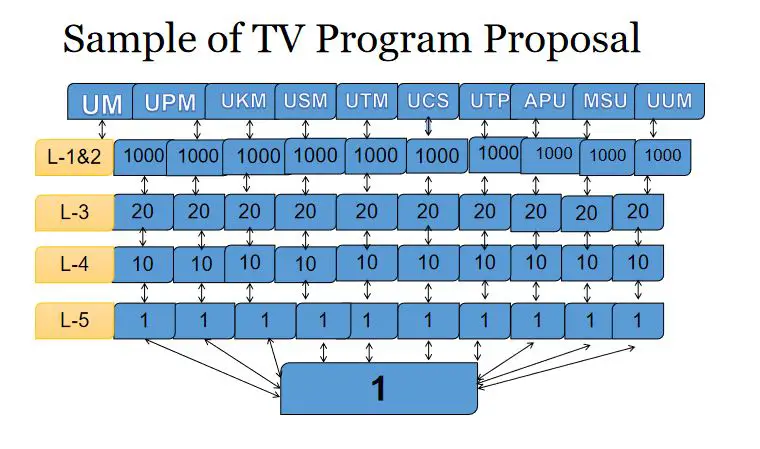
Questions Patterns Set For the TV Program
- General Knowledge
- Books and Authors
- Famous Personalities
- Geography
- History
- Science and Inventions
- Movies
- Politics
- Religious
- Sports
Full Process at a glance
- Create an account and log in.
- Choose university name, and provide student ID number for account activation.
- Level-1 (50 Questions).
- Level-2 (50 Questions).
- Level-3: Location at Alhijrah, and a total of 20 top-scored students from every university will compete to secure a position within the top 10. (Transportation, Beverage, and 100 Ringgit for the participant).
- Level-4: Location at Alhijrah and the top 10 students from every university will compete to become the most talented student of the university. (Transportation, Beverages, and 200 Ringgit for the participant).
- Level-5: Location at Alhijrah, and the top 10 students from 10 universities will compete to become the most talented student in Malaysia. .(Transportation, Beverage, and 500 Ringgit for the participant).
- Total Price –20,000 Ringgit, Winner will get 10000 Rm, Runner up 5000 Rm, and the second Runner up 2000 Rm).
Additional events for audiences
The TV channel authority will organize two additional events for audiences. First of all, the audiences who will participate in the program physically can get prizes by answering questions on the stage. These audiences are those who sit in front of the main competition stage to watch live programs. In addition, the audiences who watch this program through TV channels can win prizes by answering questions through mobile. Audiences differ from active and passive media audiences.
Target Audiences of the TV Program
Demographic, geographic, and psychographic segmentation is the most powerful audience segmentation technique. For this program, demographic segmentation is the most relevant strategy to the target audience, and audiences can be youth, adults, and senior people. Their ages may be between 15 and 65 years old. The prime target audiences of this Discover talent student program are students. Students are the main components of running this program because they will participate. Also, it will be an interactive program, viewers in front of the TV can also answer questions, and when the audience can answer the questions successfully, they will feel delighted. The contestants and audiences face various topics, such as general knowledge, common sense, literature, history, astronomy, geography, sports, and entertainment. So, audiences can also increase their knowledge through our questions answering session; simultaneously, they can win prizes.
Youth
The motive for choosing youth as the target audience is because they have already received a part of the education and have a specific knowledge background. And our program can be a competition; youth could set up a team to answer questions together to determine how many questions can be answered. In this way, they expand their knowledge and enhance friends’ relationships.
Adult
Furthermore, there are two aspects which are unemployed people and workers. Unemployed people have a lot of time can watch TV or videos, and they can learn something from our program. Our problems are so wide that they can learn something from them and benefit them in the future. Besides that, the workers didn’t have more free time to watch our program to relax. When they are tired, they can watch our program. If they can answer the questions correctly, they feel happy.
Senior people
Maybe not many o people watch our show, but we hope to have more older people to watch. Because they can learn and educate their grandchildren.
Justifications
The reason why TV al-Hijrah should produce this program has been discussed here. There are two major reasons for producing this program. Firstly, there’s something unique about producing a program based on students and centering universities in Malaysia. So, It’s a whole new format. Secondly, because the nature of the show is not just entertainment, some common sense questions make the show educational. On the other hand, the program has a wide range of audiences because of its educational significance.
The uniqueness of the program
Firstly, The nature of this show is unique in Malaysia because Malaysian TV programs are mostly about travel, food reality shows, and music-related selection programs. People’s conformity, snooping, and curiosity all affect people’s attention to TV programs. Therefore, the new format surely attracts some viewers. On the other hand, previous reality shows were mostly celebrities, but participants in this program were students from the top 10 universities in Malaysia. This kind of guest on the TV program makes the show more attractive. Finally, we intend to give some students who have talent but have not yet been able to shine.
Advantages of the programs
Firstly, compared with the variety of entertainment programs, this program has educational meaning. This program can also attract primary and middle school, and college students interested in exercising their knowledge through competition. Secondly, the program can also raise social awareness among general people to focus on learning and participants obtain confidence. Finally, this program can increase the popularity of the TV channel by increasing ratings.
In conclusion, the tv program proposal is crucial to explain the show’s benefits. It convinces the authority to telecast the show.
